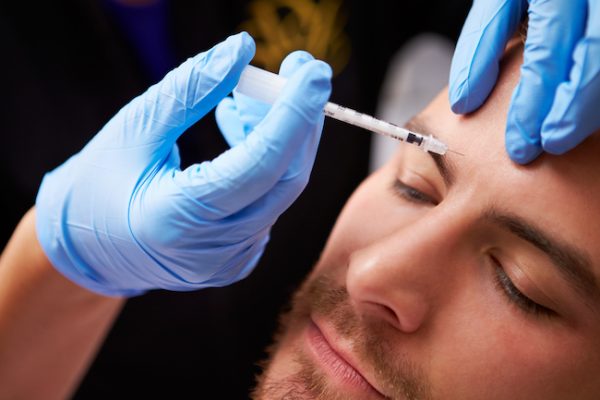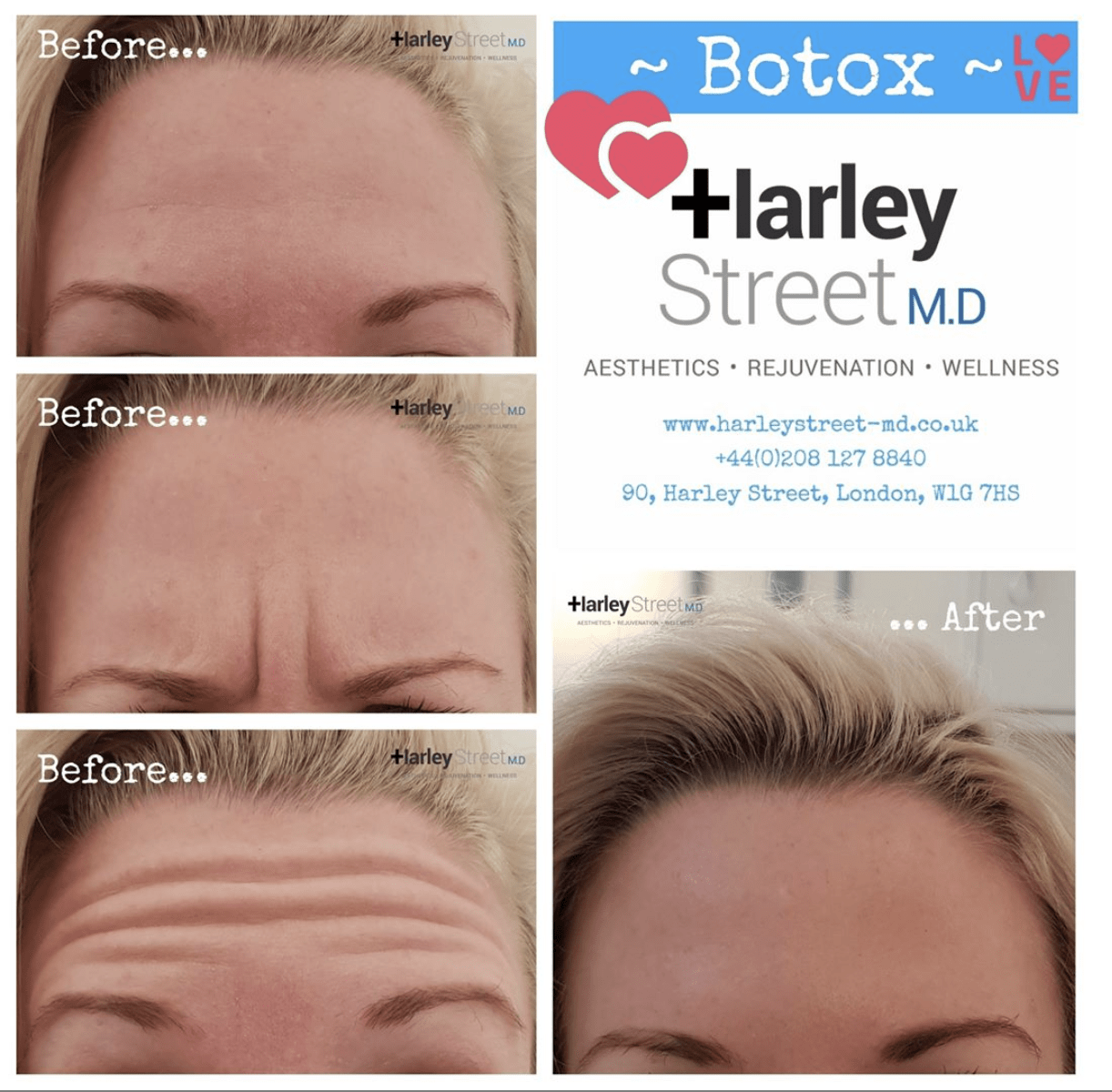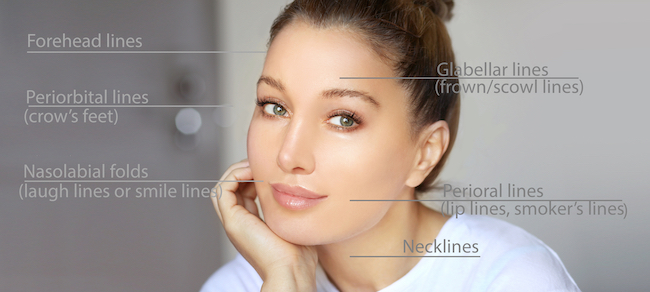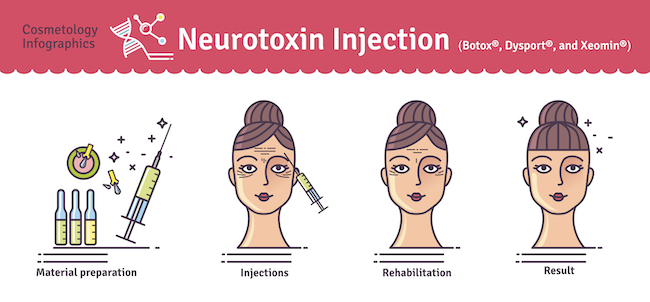
Botulinum Toxin injections are most commonly known by their shortened term, Botox injections. Botox has become such a household name that it’s unsurprising to learn that in 2020 Botox treatments accounted for 43.2% of non-surgical treatments carried out according to the 2020 Global Survey from ISAPS.
But despite Botox and dermal fillers being some of the most popular cosmetic treatments in the UK, you may still be concerned about whether Botox is safe.
In this guide will cover everything you need to know about Botox.
1. What Is Botox?
2. What Is Botox Made From?
3. What Is Botox Used For?
4. Is BotoxPainful?
5. Is Botox Safe?
6. What are the Risks of Botox?
7. Dos and Don’ts of Botox
8. How Can You Minimise the Risks of Botox?
9. Picking a Safe and Reputable Botox Practitioner in London
According to the NHS, botulinum toxin or Botox injections “relax the muscles in your face to smooth out lines and facial wrinkles, such as crow’s feet and frown lines”. Usually administrated by a fine needle, Botox injections can also help to treat medical conditions such as excessive sweating, chronic migraines and eye spasms.
Even though Botox is a toxin, it’s considered a generally safe cosmetic treatment with relatively few risks. Over the past decade, it has become commonplace, with many celebrities using it to enhance their natural beauty.

Botox treatments are considered safe, so you might be surprised to hear that botulinum toxin is actually a purified protein from the same toxin that causes botulism, a type of food poisoning that can weaken the nervous system.
It makes sense then, that Botox injections weaken or paralyse the muscles or block certain nerve endings to cause muscle weakness in the places where there’s an issue.
This might sound scary, but the doses used in a Botox treatment are tiny, so they’re unlikely to affect you negatively, and Botox is considered a safe treatment. Like most cosmetic procedures, there is a chance of some side effects. We’ll explain these later in the article and how you can minimise the risks as much as possible.
First, let’s look at why you might choose to get botulinum toxin treatment. You might be surprised that Botox injections are used for a wide range of purposes.

Botulinum toxin or Botox injections are not just for cosmetic use but are regularly used to enhance your natural beauty.
Below is a list of health conditions and cosmetic purposes where Botox treatment might be an option. This is just a small example, with Botox currently being trialled for some surprising reasons like depression and premature ejaculation. It is always best to book a consultation with a professional before getting a botulinum toxin injection.
• Chronic migraines
• Muscle contractures associated with cerebral palsy
• Overactive bladder
• Lazy eye or eye twitching.
• Forehead wrinkles
• Fine lines and wrinkles around the eyes
• Crow’s feet
• Eyebrow arches
• Nose lines
• Gummy smile
• Dimpled chin
• Fuller lips as an alternative to dermal fillers
• Drooping eyelids or lips
• Lines and wrinkles around the mouth and lips also known as “smokers lines”.
• Lines on the neck
• To soften a jawline.
An experienced practitioner will use a topical anaesthetic at the injection site, so many people report that a Botox injection can feel relatively pain-free. The needle used to administer Botox injections is usually very fine to minimise any pain or potential bruising.
Once the anaesthetic has worn off, it’s not uncommon to feel a little pain at the injection site, but this should disappear after a short time.

The straightforward answer to this is yes. By using an experienced doctor or practitioner, there are few risks involved with Botox itself. This paper by the National Library of Medicine explains that there are no long-term or life-threatening effects based on administrating the correct dose for a cosmetic treatment.
However, as with all plastic surgery, there is a more nuanced answer. Botox wears off after two to six months, so it’s natural to want to “top-up” your Botox. With prolonged use, botulinum toxins may result in an under-animated face. The best way to avoid this is to work with an experienced doctor who can administer the correct amount to create a natural-looking result.
There are some potential common side effects following Botox, ranging from minor to serious symptoms. Here we’ll explore some of the most common. If you are worried, you should always speak to your practitioner or consult a healthcare professional.
• Redness — This is common after an injection of any kind and you can expect this to go down after 30 minutes or so. If it persists, it might be infected and you should seek help.
• Bruising — This may occur in more sensitive areas, but a good practitioner can reduce the chance of this happening. Bruises should fade naturally after a week or two.
• Infection — Always keep the injection site clean after your procedure to avoid infection. However, if the Botox area looks red and swollen, visit the doctor’s office to get some antibiotics.
• Pain at the injection site — It’s common for this to occur after any anaesthetic has worn off. Apply a cold compress to the area to ease the pain.
• Muscle weakness or stiffness — Provided this is a relatively mild feeling, this is also quite common, but if you’re worried, speak to your practitioner.
• Headache, Cold or flu-like symptoms — Along with a headache, these can be common after Botox and should fade after 24 hours. Drink plenty of water, rest, and consult your doctor if the symptoms persist.
• Blurred vision — Sometimes known as double vision, this can sometimes occur after injections around the eyes. This is uncommon and will wear off with the Botox, but you should consult your doctor.
• Allergic reaction — If you experience itchiness, a rash, trouble swallowing or breathing, or severe dizziness, seek help immediately as you may be experiencing an allergic reaction. This is uncommon but something to be aware of.
• Crooked or droopy eyelids or mouth — Web MD explains, “Around 5% of people who get Botox will have problems with eyelid droop. This number falls to less than 1% if a skilled doctor does the injection”. While this isn’t a serious health problem, it can affect your mental health. Avoid this by finding a practitioner with great reviews and plenty of experience.

The best way to achieve natural-looking Botox that enhances your features is to look for a reputable practitioner with plenty of experience.
Make sure you begin with a consultation to outline exactly what you want to achieve. Your practitioner should be honest with you about what’s possible, and you should leave the consultation with a good idea of what to expect.
If you’re worried about the safety and risks involved with the procedure, a good practitioner can reassure you and advise you about the aftercare needed.
The side effects of Botox are minimal. Get plenty of rest, keep the treatment area clean and free of make-up for the first day, try not to touch it and your Botox should stay looking great for up to six months.
Below are some dos and don’ts of having Botox injections.

• Avoid blood thinners — ask your doctor whether you should stop taking these a few days before the procedure to minimise bruising.
• Do some gentle face exercises — smiling, frowning and laughing are all fine too.
• Relax for the rest of the day to maintain a normal heart rate, as increased blood pressure can increase the risk of bruising.
• Avoid exercise for 24 hours; you should avoid overheating as this can increase the chance of bruising.
• Go make-up-free for 24 hours to give the area a chance to breathe. Keeping the area clean also reduces the chance of infection.
• Don’t drink alcohol — Wait at least 24 hours after your injection before consuming alcohol to reduce the risk of bruising.
• Don’t rub your face for one to three days to avoid spreading the toxin.
• Avoid other skin treatments like massage, facials, exfoliating or dermal fillers.
• Don’t sleep on the treated areas and don’t sleep at all within four hours of the procedure.
• Stay out of the sun for at least four hours and avoid extreme direct sunlight for a day or two to reduce the risk of bruising.
• Avoid tan beds, hot tubs, saunas, hot showers or baths. Heat exposure can encourage bruising.
It’s important to feel safe and comfortable with the practitioner administering your Botox treatment, so look out for the following when choosing a Botox practitioner or clinic in London.
• They should be a medical professional, such as a doctor, nurse or dentist.
• The clinic is accredited by a reputable awarding body, such as the General Medical Council, the Royal College of Surgeons or a college of aesthetic medicine.
• They offer you a consultation beforehand to discuss what you hope to achieve.
• They are honest about what you can achieve with Botox alone and may offer alternative or additional treatment.
• They have great testimonials from other happy clients.
• They offer a two-week check-in to ensure you’re satisfied with your results.
The doctors at Harley Street MD work with their clients to achieve a look that makes them feel happy and confident. Our Botox injections are always administered by medical professionals, and you can expect a friendly, discreet service from our beautiful Harley Street location in London.
We provide Botox in London. An initial consultation with one of our doctors is obligation-free and costs nothing, so even if you’re curious about the results you can achieve with Botox injections, it’s worth getting in touch. Contact us today to book yours.